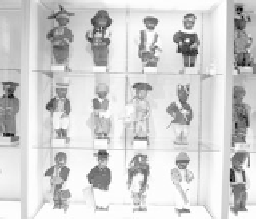Travel Reference
In-Depth Information
in February of 1848 to write their
Communist Manifesto.
Later
that year, when the treatise sparked socialist revolution around
Europe, Brussels exiled them. Today, the once-proletarian bar is
one of the city's most expensive restaurants. Next door (#10) was
and still is the brewers' guild, now housing the
Brewery Museum
(see page 387).
he
statues
on the rooftops each come with their own unin-
teresting legend, but the Bruxelloise have an earthier explanation:
“What's that smell?” say the statues on
the roof of the Swan House. “Someone
farted.” “Yeah,” says the golden man rid-
ing a horse atop the Brewery Museum
next door, “it was that guy over there,”
and he points north across the square to
another statue. “It wasn't me,” says that
statue, “it was him—way over there.”
Follow his gaze to the southwest cor-
ner of the square, where a statue of St.
Nicolas...hangs his head in shame.
• In the King's House (across from the Town
Hall) is the only museum of any importance on the square...
City Museum
The museum's top f loor has a roomful of goofy costumes the
Manneken
statue has pissed through, the middle f loor features
maps and models of old Brussels, and
the bottom floor has a few old paint-
ings, fine carved altarpieces, and tap-
estries. On the ground floor, you'll see
the original statues that once adorned
the Town Hall. The local limestone is
no match for the corrosive acidic air,
so they were brought inside for protec-
tion. Most visitors aim straight for the
Manneken-Pis
outfits. Once up there,
sit down and enjoy the video showing visitors' reactions to the
ridiculous little statue.
But be sure to find the model of the city in the 13th century,
on the second floor. (To follow the directions in this description,
uphill is east.) The largest structure is St. Michael's Cathedral
(northeast). The Upper Town hasn't a hint of its monumental
future. The Grand Place's embryonic beginning is roughly in the
center of town, amid a cluster of houses.
The city was a port town—see the crane unloading barges—
since it was at this point that the shallow Senne became navigable.
Grain from the area was processed in the watermills, then shipped






















